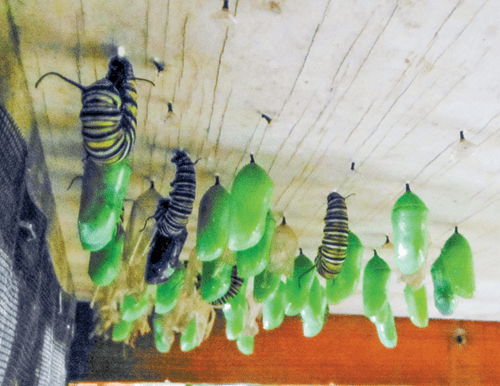Some 230 winged guests have already checked out
BY VEA NABOKOV Special to the VOICE
In a quiet corner of Fenwick, a different kind of animal rescue has taken place this summer. Resident Carolyn Botari has been rescuing monarch eggs and caterpillars and raising them to adulthood in her specially built “Monarch Manor.”
“Late May was the first, most critical time to collect the eggs and caterpillars,” said Botari, as ditch-mowing in early June would wipe out most first-generation monarchs living along roadsides. It is habitat loss and the use of pesticides and herbicides that has negatively impacted the population of monarch butterflies across North America.
Monarchs arriving from the US in May lay their eggs on milkweed plants. It can take anywhere from three to ten days for the eggs to hatch into caterpillars. The larvae/caterpillars devour milkweed for several more weeks as the caterpillars molt and grow.
“I have a good supply of milkweed around my neighbourhood that I clip leaves from to feed the growing caterpillars,” said Botari. “I also have friends and family who regularly drop off weed when needed.”
When the caterpillar is ready to pupate, it climbs to the ceiling of the Monarch Manor, spins a silk to attach itself, and hangs head-down in a “J” shape for around 24 hours. Shortly before its final molt, the caterpillar straightens some and within an hour or so sheds its exoskeleton.

The pupa then begins to change into a beautiful jade with gold trim chrysalis that the Monarch is so well known for. After about two weeks, the pupa darkens and become transparent. Right before the butterfly emerges, its wings become visible inside the chrysalis.
When the Monarch emerges, it has crumpled wings and must hang for several hours to pump them full of fluids and dry them.
There are usually between 30 to 40 chrysalis hanging in the Monarch Manor.
“So far around 230 butterflies have been released here in Fenwick,” said Botari. “There are four generations of butterflies that live in Southern Ontario. The first three generations live only a few weeks to mate and lay the next generation of eggs. The caterpillars that are just hatching now will be the fourth generation and become the migrating monarchs which will fly to Mexico, live there for six months, breed, and then die.”
Botari said that she will tag these butterflies for tracking through Monarch Watch, a non-profit conservation and research program based at the University of Kansas.
This year there have been more caterpillars and butterflies surviving along the roadside as Town staff have not mowed the ditches since June. Another caterpillar rescue will take place in late August into early September, prior to the Town’s autumn mowing.
“These will be caterpillars that become our fall migrating monarchs.”
Carolyn has expanded her butterfly rearing to include a second hatchery, “Swallowtail Inn.”
“I found a number of swallowtail caterpillars on my dill plants this summer,” said Botari, adding that they will pupate and overwinter as a chrysalis.
“Since they are presently living in my vegetable garden, the chances that their chrysalis’ will not be knocked down during fall clean up are slim, so they have been moved into their own hatchery for release next spring.”
Residents can support butterfly populations by planting varieties of flowers, allowing milkweed to grow, and avoiding the use of pesticides.


